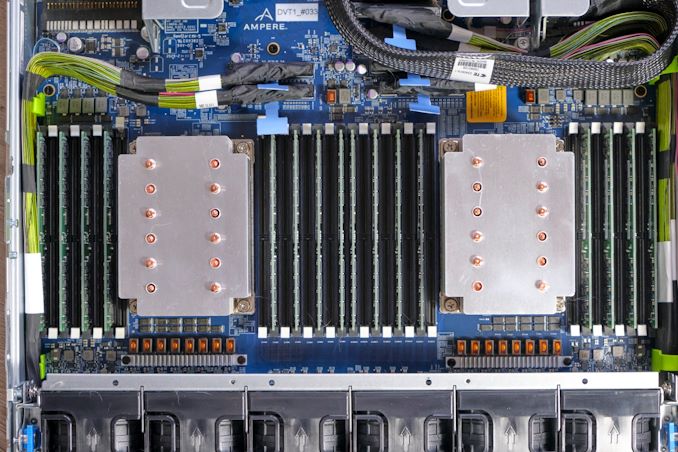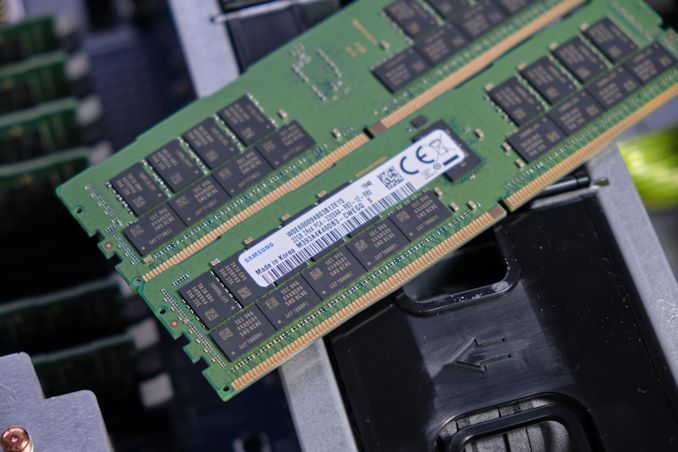The Ampere Altra Review: 2x 80 Cores Arm Server Performance Monster
by Andrei Frumusanu on December 18, 2020 6:00 AM EST- Posted in
- Servers
- Neoverse N1
- Ampere
- Altra
Test Bed and Setup - Compiler Options
For the rest of our performance testing, we’re disclosing the details of the various test setups:
Ampere "Mount Jade" - Dual Altra Q80-33
Obviously, for the Ampere Altra system we’re using the provided Mount Jade server as configured by Ampere.
The system features 2 Altra Q80-33 processors within the Mount Jade DVT motherboard from Ampere.
In terms of memory, we’re using the bundled 16 DIMMs of 32GB of Samsung DDR4-3200 for a total of 512GB, 256GB per socket.
| CPU | 2x Ampere Altra Q80-33 (3.3 GHz, 80c, 32 MB L3, 250W) |
| RAM | 512 GB (16x32 GB) Samsung DDR4-3200 |
| Internal Disks | Samsung MZ-QLB960NE 960GB Samsung MZ-1LB960NE 960GB |
| Motherboard | Mount Jade DVT Reference Motherboard |
| PSU | 2000W (94%) |
The system came preinstalled with CentOS 8 and we continued usage of that OS. It’s to be noted that the server is naturally Arm SBSA compatible and thus you can run any kind of Linux distribution on it.
Ampere makes special note of Oracle’s active support of their variant of Oracle Linux for Altra, which makes sense given that Oracle a few months ago announced adoption of Altra systems for their own cloud-based offerings.
The only other note to make of the system is that the OS is running with 64KB pages rather than the usual 4KB pages – this either can be seen as a testing discrepancy or an advantage on the part of the Arm system given that the next page size step for x86 systems is 2MB – which isn’t feasible for general use-case testing and something deployments would have to decide to explicitly enable.
The system has all relevant security mitigations activated, including SSBS (Speculative Store Bypass Safe) against Spectre variants.
AMD - Dual EPYC 7742
For our AMD system, unfortunately we had hit some issues with our Daytona reference server motherboard, and moved over to a test-bench setup on a SuperMicro H11DSI0.
We’re also equipping the system with 256GB per socket of 8-channel/DIMM DDR4-3200 memory, matching the Altra system.
| CPU | 2x AMD EPYC 7742 (2.25-3.4 GHz, 64c, 256 MB L3, 225W) |
| RAM | 512 GB (16x32 GB) Micron DDR4-3200 |
| Internal Disks | OCZ Vector 512GB |
| Motherboard | SuperMicro H11DSI0 |
| PSU | EVGA 1600 T2 (1600W) |
As an operating system we’re using Ubuntu 20.10 with no further optimisations. In terms of BIOS settings we’re using complete defaults, including retaining the default 225W TDP of the EPYC 7742’s, as well as leaving further CPU configurables to auto, except of NPS settings where it’s we explicitly state the configuration in the results.
The system has all relevant security mitigations activated against speculative store bypass and Spectre variants.
Intel - Dual Xeon Platinum 8280
For the Intel system we’re also using a test-bench setup with the same SSD and OS image actually – we didn’t have enough RAM to run both systems concurrently.
Because the Xeons only have 6-channel memory, their maximum capacity is limited to 384GB of the same Micron memory, running at a default 2933MHz to remain in-spec with the processor’s capabilities.
| CPU | 2x Intel Xeon Platinum 8280 (2.7-4.0 GHz, 28c, 38.5MB L3, 205W) |
| RAM | 384 GB (12x32 GB) Micron DDR4-3200 (Running at 2933MHz) |
| Internal Disks | OCZ Vector 512GB |
| Motherboard | ASRock EP2C621D12 WS |
| PSU | EVGA 1600 T2 (1600W) |
The Xeon system was similarly run on BIOS defaults on an ASRock EP2C621D12 WS with the latest firmware available.
The system has all relevant security mitigations activated against the various vulnerabilities.
Compiler Setup
For compiled tests, we’re using the release version of GCC 10.2. The toolchain was compiled from scratch on both the x86 systems as well as the Altra system. We’re using shared binaries with the system’s libc libraries.












148 Comments
View All Comments
mostlyfishy - Friday, December 18, 2020 - link
Interesting article thanks. One thing I missed, what process is this on? 7nm?It's also interesting that the M1 has demonstrated that with the right sizings, a very wide backend can give you significant single threaded performance. Not really that useful for a server processor where you're likely to be running many threads and want to trade for more cores though.
Josh128 - Friday, December 18, 2020 - link
Yes, 7nm and monolithic, which seems fairly incredible as this thing is huge. Dont have the die size numbers though. Wonder what the yield is on these...Calin - Friday, December 18, 2020 - link
Maybe there are quite a few more than 80 cores on this beast - in which case you can "eat" some die errors by deactivating cores/complexes/...Wilco1 - Friday, December 18, 2020 - link
Each Neoverse N1 core with 1MB L2 is just 1.4mm^2, so 80 of them add up to 112mm^2. The die size is estimated at about 350mm^2, so tiny compared to the total ~1100mm^2 in EPYC 7742.So performance/area is >3x that of EPYC. Now that is efficiency!
andrewaggb - Friday, December 18, 2020 - link
Timing of this article is awkward. We're comparing to the 18 month old 7742 vs the soon to be released Zen 3 Milan parts which based on the already launched Zen 3 desktop parts (and Milan leaks) will be 9-27% faster in the same power envelope.Cache is a big part of the die size for the AMD chip and the N1 has much less of it which makes the die size smaller. AMD's Desktop IGP parts with way less cache perform very similarly in many workloads to those with the extra cache and the same has been true for intel parts over the years. Some workloads don't benefit much at all from the extra cache and some do which makes choosing the benchmarks more important.
That's not to say the N1 isn't more efficient, but rather that it's hard to make a fair comparison, particularly around die size. They may have similar core counts but have made very different design decisions around cache.
Wilco1 - Friday, December 18, 2020 - link
I don't see how it matters, but Altra is about 9 months old and Neoverse N1 is a sibling of Cortex-A76 which has been available in phones for 2 years. As for Milan, I expect the gain on SPECrate to be about 10-15%. And Milan will be competing with the Altra Max which has 60% more cores which should give ~40% speedup.Yes the design decisions are quite different, and it is interesting that they end up with similar performance despite the disparity in L3 cache. I suspect that 8 memory channels is becoming a limit, and a future generation with DDR5 will enable more throughput (and even more cores).
Gondalf - Friday, December 18, 2020 - link
I am sorry but looking carefully the heatsink and the application of the thermal paste, we are facing a limit of the reticle thing on 7nm.We are in front of a 700/800 mm2 thing. On 7nm this means very few units sold and nearly zero market penetration. Same thing on 5nm given the higher core numbers.
In pratics we have nothing in our hands. Another failure in Server market
Andrei Frumusanu - Friday, December 18, 2020 - link
Ampere is doing Altra Max with 128 cores still on 7nm, so this one certainly isn't near hitting reticle limits.Wilco1 - Friday, December 18, 2020 - link
No it is not anywhere near the reticle limit. You can't estimate the die size from the heatsink, but you estimate it based on similar designs for which we do have numbers. Graviton 2 is a similar design at 30B transistors. This has another 16 cores which adds another 16X1.4 = 22.4mm^2. So around 350mm^2 in N7.milli - Monday, December 21, 2020 - link
This is just a ridiculous statement. 350mm^2 ... no way.Firstly, the die size of Graviton 2 is not known.
A realistic comparison would be AMD's Zen2 chiplet which has 3.9b transistors and is 72mm^2.
One would deduce from that, that Graviton 2 is > 550mm^2. Also your napkin calculation to add 22mm2 is flawed. Firstly, you don't know if a N1 core is actually taking 1.4mm^2 in this CPU. Secondly, you're forgetting to add 64 PCI-E lanes.
Let's say, 25mm2 for the CPU and 25mm2 for the lanes. That would bring the total to 600mm^2. Quite a bit bigger to your 350mm^2.